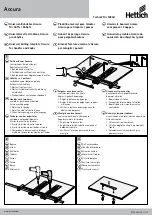
16
27). Several passes may be necessary for the
tearout (Fig. 26). If the direction of the grain
planing, use push blocks. (Fig. 25)
(Fig. 24)
Figure 27
Figure 26
For jointing and planing cuts pressure is directed
three ways; into the fence to ensure a square
cut, forward to advance the stock, and
downward to avoid chatter and vibration.
For jointing when the material is higher than the
fence, the left hand applies pressure into the
fence and down toward the table while the right
hand pushes forward from behind. Be sure to
keep the right hand high up on the material.
For jointing material that is lower than the fence,
use push sticks to protect the hands. For
Never
place the right hand on the trailing edge of
the material. Hand placement on the trailing
edge of the material may cause the hand to
come into contact with the blade.
Feed work from right to left at a steady,
moderate speed. If you feed the material too
slowly, the wood will burn in places. If you feed
the material too quickly, ridges will appear in the
finished surface.
Jointing Warped Material
If the work to be jointed is cupped or warped,
take light, repetitive cuts until the surface is flat.
Forcing the material flat against the table will still
leave a warped piece after the cuts have been
made.
Never joint any material
shorter than eight inches! The material may
tip into the jointer’s throat and be kicked
back! Avoid jointing thin material which
could become jammed under the fence or
blade guard! Failure to comply may cause
serious injury!
Direction of Grain
Feed the material with of the grain to avoid
changes somewhere in the board, try reducing
depth of cut and slow the feed speed down to
avoid tearout. If results still aren’t satisfactory,
turn the material around and try feeding through
the other way.
Bevel Cut
To cut a bevel, lock the fence at the desired
angle and run the material through, pressing the
work firmly against the fence and tables (Fig.
desired result.








































